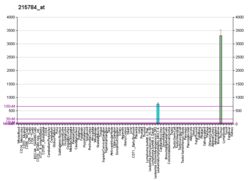T-cell surface glycoprotein CD1e, membrane-associated is a protein that in humans is encoded by the CD1E gene.
This gene encodes a member of the CD1 family of transmembrane glycoproteins, which are structurally related to the major histocompatibility complex (MHC) proteins and form heterodimers with beta-2-microglobulin. The CD1 proteins mediate the presentation of primarily lipid and glycolipid antigens of self or microbial origin to T cells. The human genome contains five CD1 family genes organized in a cluster on chromosome 1. The CD1 family members are thought to differ in their cellular localization and specificity for particular lipid ligands. The protein encoded by this gene localizes within Golgi compartments, endosomes, and lysosomes, and is cleaved into a stable soluble form. The soluble form is required for the intracellular processing of some glycolipids into a form that can be presented by other CD1 family members. Several alternatively spliced transcript variants encoding different isoforms have been described. Additional transcript variants have been found; however, their biological validity has not been determined.
See also
References
- ^ GRCh38: Ensembl release 89: ENSG00000158488 – Ensembl, May 2017
- "Human PubMed Reference:". National Center for Biotechnology Information, U.S. National Library of Medicine.
- Angenieux C, Salamero J, Fricker D, Cazenave JP, Goud B, Hanau D, de La Salle H (Dec 2000). "Characterization of CD1e, a third type of CD1 molecule expressed in dendritic cells". J Biol Chem. 275 (48): 37757–64. doi:10.1074/jbc.M007082200. PMID 10948205.
- ^ "Entrez Gene: CD1E CD1e molecule".
Further reading
- Brigl M, Brenner MB (2004). "CD1: antigen presentation and T cell function". Annu. Rev. Immunol. 22 (1): 817–90. doi:10.1146/annurev.immunol.22.012703.104608. PMID 15032598.
- Calabi F, Jarvis JM, Martin L, Milstein C (1989). "Two classes of CD1 genes". Eur. J. Immunol. 19 (2): 285–92. doi:10.1002/eji.1830190211. PMID 2467814. S2CID 31384394.
- Yu CY, Milstein C (1990). "A physical map linking the five CD1 human thymocyte differentiation antigen genes". EMBO J. 8 (12): 3727–32. doi:10.1002/j.1460-2075.1989.tb08548.x. PMC 402056. PMID 2583117.
- Albertson DG, Fishpool R, Sherrington P, et al. (1988). "Sensitive and high resolution in situ hybridization to human chromosomes using biotin labelled probes: assignment of the human thymocyte CD1 antigen genes to chromosome 1". EMBO J. 7 (9): 2801–5. doi:10.1002/j.1460-2075.1988.tb03135.x. PMC 457071. PMID 3053166.
- Martin LH, Calabi F, Milstein C (1987). "Isolation of CD1 genes: a family of major histocompatibility complex-related differentiation antigens". Proc. Natl. Acad. Sci. U.S.A. 83 (23): 9154–8. doi:10.1073/pnas.83.23.9154. PMC 387093. PMID 3097645.
- Adams MD, Kerlavage AR, Fleischmann RD, et al. (1995). "Initial assessment of human gene diversity and expression patterns based upon 83 million nucleotides of cDNA sequence" (PDF). Nature. 377 (6547 Suppl): 3–174. PMID 7566098.
- Han M, Hannick LI, DiBrino M, Robinson MA (2000). "Polymorphism of human CD1 genes". Tissue Antigens. 54 (2): 122–7. doi:10.1034/j.1399-0039.1999.540202.x. PMID 10488738.
- Mirones I, Oteo M, Parra-Cuadrado JF, Martínez-Naves E (2001). "Identification of two novel human CD1E alleles". Tissue Antigens. 56 (2): 159–61. doi:10.1034/j.1399-0039.2000.560208.x. PMID 11019917.
- Tamouza R, Sghiri R, Ramasawmy R, et al. (2003). "Two novel CD1 E alleles identified in black African individuals". Tissue Antigens. 59 (5): 417–20. doi:10.1034/j.1399-0039.2002.590509.x. PMID 12144626.
- Angénieux C, Salamero J, Fricker D, et al. (2003). "Common characteristics of the human and rhesus macaque CD1e molecules: conservation of biochemical and biological properties during primate evolution". Immunogenetics. 54 (12): 842–9. doi:10.1007/s00251-003-0538-0. PMID 12671734. S2CID 2302966.
- Angénieux C, Fraisier V, Maître B, et al. (2005). "The cellular pathway of CD1e in immature and maturing dendritic cells". Traffic. 6 (4): 286–302. doi:10.1111/j.1600-0854.2005.00272.x. PMID 15752135. S2CID 6199618.
- de la Salle H, Mariotti S, Angenieux C, et al. (2005). "Assistance of microbial glycolipid antigen processing by CD1e". Science. 310 (5752): 1321–4. Bibcode:2005Sci...310.1321D. doi:10.1126/science.1115301. PMID 16311334. S2CID 20963542.
- Kimura K, Wakamatsu A, Suzuki Y, et al. (2006). "Diversification of transcriptional modulation: large-scale identification and characterization of putative alternative promoters of human genes". Genome Res. 16 (1): 55–65. doi:10.1101/gr.4039406. PMC 1356129. PMID 16344560.
- Caporale CM, Papola F, Fioroni MA, et al. (2006). "Susceptibility to Guillain–Barré syndrome is associated to polymorphisms of CD1 genes". J. Neuroimmunol. 177 (1–2): 112–8. doi:10.1016/j.jneuroim.2006.05.018. PMID 16820217. S2CID 21604886.
External links
- CD1E+Antigen at the U.S. National Library of Medicine Medical Subject Headings (MeSH)
- Human CD1A genome location and CD1A gene details page in the UCSC Genome Browser.
- Human CD1E genome location and CD1E gene details page in the UCSC Genome Browser.
| Proteins: clusters of differentiation (see also list of human clusters of differentiation) | |
|---|---|
| 1–50 | |
| 51–100 | |
| 101–150 | |
| 151–200 | |
| 201–250 | |
| 251–300 | |
| 301–350 | |
This membrane protein–related article is a stub. You can help Misplaced Pages by expanding it. |



